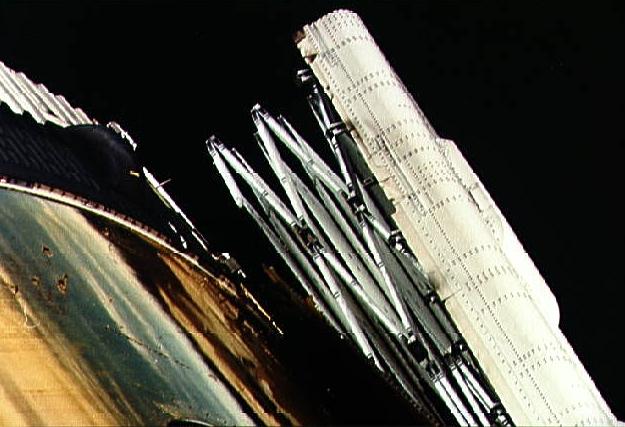I trust no one is suggesting rushing up a Soyuz as a means of providing reentry for some of the crew of Columbia, because a single Soyuz--even if flown up to Columbia rendezvous completely unmanned, under automatic or ground control--can only return 3 of the 7 Columbia crew to Earth. You'd need three of them for that. Of course if a Soyuz could get there long before February 14 and take down three, the remaining 4 on Columbia would have longer than Feb 15 to live. But the Russians can't do it from their launching pads even if they happened to have one ready to launch when NASA announced the bad news, and we've discussed other limitations that would have to be overcome if one magically materialized atop the Ariane or some other rocket, ready to go. Such as lading it with more EVA suits to ferry a third astronaut over to the Soyuz, and more suits for the 4 left behind, and more LiOH canisters to leave with Columbia, etc.
A Soviet capsule that would do them some good would be a Progress cargo hauler, bringing supplies to extend the time they can survive in orbit, allowing the Atlantis launch to be less rushed.
And it has to be launched on a different rocket than the Russians use since neither Kourou nor I suppose the alternatives--Canaveral and the Japanese launching site are the only ones that come to mind--have the special gantries and stuff the Russian rocket needs.
Besides Ariane, and ICBMs which no, I don't think can accomplish much of what is needed, what sort of heavy launchers did the US military have in stock, or on order and essentially ready to go, in these weeks? It would be basically a choice between the biggest Titan and the biggest Atlas. As far as I can tell, in early 2003 the new Delta IV was not yet quite ready nor was the late-generation Atlas, but Titan IVB was being retired in their favor, and the last Titan IV launched a military payload in April. I don't think we can count on it being available in late January or early February, and I'm not sure if it launched from Vandenberg or Canaveral.
That would be the heaviest payload launcher; a great many types in the less than ten tonne to LEO range (Ariane IV falls into this range) typically lifting about 7 tonnes might have been more available and launchable from more sites.
I think Team Blue needs to identify just which system is most available well before Feb 14 and plan around a 5-8 tonne system to deliver vital necessities to Columbia.
A Progress capsule might do the job, and seems to me to be fittable on many candidate rockets. But if no one has ever done that integration before, it would presumably take some time to iron out bugs. It seems more likely that it would be a hasty ad hoc unique thing made in the USA most likely. And launched on a Delta or a number of foreign equivalents--the Japanese rockets for instance were derived, as Deltas were, from the old Thor series and have as it were evolved in parallel.
Again, all of this is just a contingency in case the accelerated schedule for Atlantis's launch slips.

